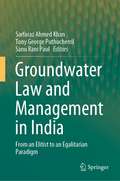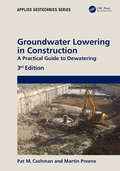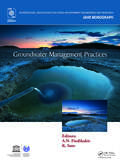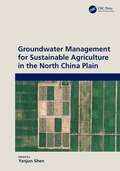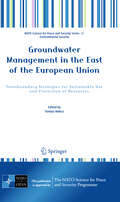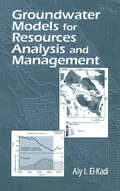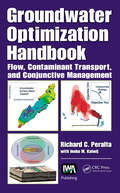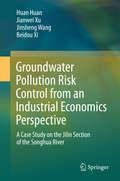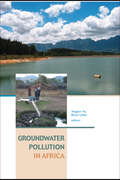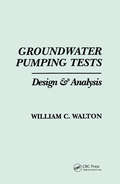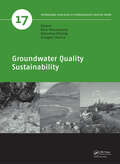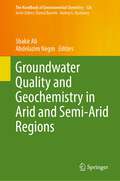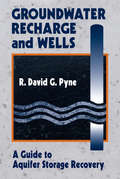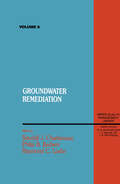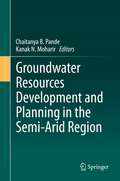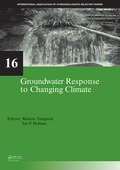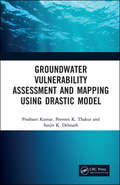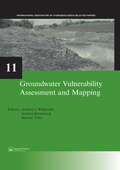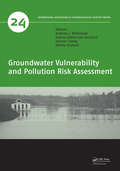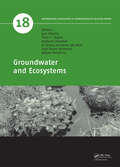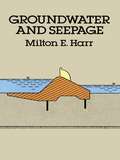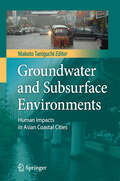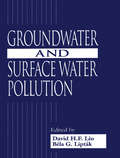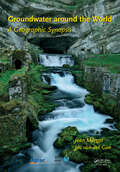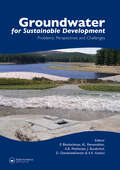- Table View
- List View
Groundwater Law and Management in India: From an Elitist to an Egalitarian Paradigm
by Sarfaraz Ahmed Khan Tony George Puthucherril Sanu Rani PaulThis book presents a comprehensive analysis of the existing nature of India’s groundwater laws. In the backdrop of the gravity of groundwater crisis that threatens to engulf the country, the book examines the correlation between the imperfections in the law and water crisis and advocates a reform agenda to overhaul the legal framework. It accomplishes this objective by examining how some of the States and Union Territories regulate and manage groundwater through the legal instrumentality against the backdrop of the two conflicting paradigms: the “elitist” and the “egalitarian.” The book’s fundamental premise is that despite being an extraordinarily critical resource that supports India’s burgeoning population’s ever-increasing water demands, groundwater is abused and mismanaged. The key argument that it posits is that the elitist paradigm must give way to an egalitarian one where groundwater is treated as a common property resource. To place this message in perspective, the book’s introduction explains the dichotomy between the two paradigms in the context of groundwater. This sets the stage, after which the book is divided thematically into three parts. The first part deals with some of the general groundwater management concerns brought to the fore by the operation of the elitist paradigm. Since water is constitutionally a State subject, the second part analyses the groundwater legislations of different States and Union Territories set against their unique circumstances. As these laws do not dismantle the elitist paradigm that interlocks groundwater rights to land rights, the next part articulates the legal reform agenda where a case is made to re-engineer groundwater laws to reflect a more sustainable basis. The findings and arguments resonate with the situation in many developing countries around the world due to which the book is a valuable resource for researchers across disciplines studying this area, and also for policy makers, think tanks, and NGOs.Groundwater Management–Inter-state Water Conflicts–Aquifers–Water Markets–Water Security–Water Law Reform–Groundwater Law–Water Law–Sustainable Development–Hydrology
Groundwater Lowering in Construction: A Practical Guide to Dewatering
by Martin Preene Pat M. CashmanPraise for the Second Edition: "This is the book that the dewatering sector really needs – it is reliably based on sound theory and profound understanding of the physical processes, yet is presented in a very accessible and user-friendly manner. It draws on many, many decades of experience, and yet is utterly up to date. . . . It is a one-stop shop for the dewatering practitioner – who can nonetheless rest assured that the theoretical basis of the methods presented is flawless."— Professor Paul L. Younger, FGS, FICE, C.Geol., C.Eng., FREng, University of Glasgow, Scotland, UK "The best reference on this topic available . . . and will prove useful to a wide variety of readers ranging from junior construction engineers or dewatering contractors to theoretical hydrogeologists and environmental managers. It is rare that a book is able to bridge the gap between theoretical design guidance and practical application." — S.N. Sterling, University of Waterloo, Canada The extensively updated Groundwater Lowering in Construction: A Practical Guide to Dewatering, 3rd Edition offers practical advice on all phases of groundwater control systems, from planning and design, through installation and maintenance, and ultimately decommissioning. The expertise provided in this book can help you improve working conditions, increase project viability, save time and reduce excavation costs. Designers and managers of construction and engineering projects are given the tools necessary to effectively control groundwater. The content is divided into three sections – Principles, Design and Construction. The Principles section explains the fundamentals of groundwater flow as it relates to civil engineering excavations. The Design section explores in extensive detail site investigation, permeability assessment methods and groundwater control strategies. Chapters in the Construction section describe dewatering and exclusion techniques, and examine the complete life cycle of a groundwater control scheme, including monitoring, maintenance and decommissioning. This section incorporates eleven case histories from the authors’ casebook. The 3rd edition has been greatly revised and updated, and contains more than 200 new illustrations. The new content covers: Permeability of soils and rocks Groundwater problems for excavations in rock Groundwater control for tunnelling projects, such as shafts and cross passages Methods for assessing permeability Decommissioning of dewatering systems Optimisation of groundwater control schemes. The new, expanded content offers valuable direction that can give you a true competitive advantage in the planning and execution of temporary and permanent dewatering works for excavation and tunnelling. Written for practising engineers, geologists and construction managers, as well as postgraduate engineering students, this revamped manual on design and practice presents numerous case studies and extensive references to enhance understanding. Martin Preene is a groundwater consultant, based in the UK. He has more than 30 years’ experience working on dewatering and groundwater control projects worldwide.The late Pat Cashman was the leading British exponent of groundwater control for his generation, championing a practical and straightforward approach for more than forty years.
Groundwater Management Practices (IAHR Monographs)
by Angelos N. Findikakis Kuniaki SatoThe book presents and compares practices followed in various different countries for the development, protection and management of groundwater resources. It includes overviews of technical and non-technical aspects of groundwater management practices and selected case studies in different countries. Further it provides reviews of specific technical issues such as groundwater quality management and protection, groundwater impacts of underground structures and hazards of artificial recharge and discharge; discussions of regulatory and legal issues affecting groundwater management.
Groundwater Management for Sustainable Agriculture in the North China Plain
by Yanjun ShenThis book is a unique text that explores recent research on the management of sustainable groundwater use in the North China Plain (NCP), where aquifers are suffering the most severe over‑pumping in the world and have caused serious ecological degradation. It contains research conducted by the editor and his teams on several projects over the past 18 years.Key topics covered include: comprehensive scheme and pathways to achieve sustainable groundwater management description of theoretical basis for water saving and technologies developed in practice at field scale adjusting cropping patterns and planting structure to reduce the cultivation intensity to a suitable extent soft measures such as water metering, pricing, and water marketing being applied in groundwater management practice in the NCP. It will be an invaluable resource to graduate students, education and research staff, and agriculture or water resources authorities.
Groundwater Management in the East of the European Union
by Tomasz NaleczThis volume is the result of work carried out under the NATO SPS Study Pilot Project "Sustainable Use and Protection of Groundwater Resources - Transboundary Water Management." It contains basic information on hydrogeological conditions, groundwater management and monitoring in areas of the Belarus, Lithuanian, Polish and Ukrainian borders, simultaneously borders of the European Union with its eastern partners. In view of the importance of the rational utilization of groundwater reserves, which is essential for our future existence, the book presents recommendations for a united methodology of an integrated groundwater monitoring system in this transnational area. The contributions also cover environmental and surface water issues that have direct effects on groundwater resources. The financial dimension of resource mobilization for environmental projects in Eastern Europe also features as part of a complex project solution.
Groundwater Models for Resources Analysis and Management
by Aly I. El-KadiWritten by renowned experts in the field, this book assesses the status of groundwater models and defines models and modeling needs in the 21st century. It reviews the state of the art in model development and application in regional groundwater management, unsaturated flow/multiphase flow and transport, island modeling, biological and virus transport, and fracture flow. Both deterministic and stochastic aspects of unsaturated flow and transport are covered. The book also introduces a unique assessment of models as analysis and management tools for groundwater resources. Topics covered include model vs. data uncertainty, accuracy of the dispersion/convection equation, protocols for model testing and validation, post-audit studies, and applying models to karst aquifers.
Groundwater Optimization Handbook: Flow, Contaminant Transport, and Conjunctive Management
by Richard C. PeraltaExisting and impending water shortages argue for improving water quantity and quality management. Groundwater Optimization Handbook: Flow, Contaminant Transport, and Conjunctive Management helps you formulate and solve groundwater optimization problems to ensure sustainable supplies of adequate quality and quantity. It shows you how to more effecti
Groundwater Pollution Risk Control from an Industrial Economics Perspective: A Case Study On The Jilin Section Of The Songhua River (SpringerBriefs in Environmental Science)
by Beidou Xi Huan Huan Jianwei Xu Jinsheng WangThis book argues that groundwater pollution risk assessment is the essential foundation of groundwater pollution prevention and control. It is on this basis that economic leverage is used to make new breakthroughs in groundwater protection and governance. Presenting a case study on the Jilin Section of the Songhua River, the book applies the overlay index method to assess the shallow groundwater pollution risk and identify high-risk areas and major pollution sources in an effort to identify the mechanism of interaction between industrial structures and groundwater pollution. Further, it proposes concrete measures for preventing and controlling groundwater pollution from an industrial economics perspective. As such, the book offers a valuable resource for all graduate students, lecturers and researchers who are interested in learning about resources and environmental economics.
Groundwater Pollution in Africa
by Yongxin Xu Brent UsherIn 2000, various UN organizations launched a collaborative effort to assess the vulnerability of groundwater in several African cities. The project addressed the issue of aquifer vulnerability and the protection of groundwater quality. This book is a collection of thirty peer-reviewed papers on the topic, and provides a glimpse of the situation acr
Groundwater Pumping Tests
by William C. WaltonThis practical book 'Groundwarer Pumping Tests', details concepts, techniques, field work, case studies, and microcomputer models-information designed to improve accuracy and reliability. The reader is expected to have a working knowledge of hydrogeology or access to books on groundwater geology and hydrology. Too frequently, groundwater pumping test design and analysis ignore well storage capacity, delayed gravity yield, well partial penetration, and aquitard storativity impacts without proving them negligible. As a result, erroneous conclusions are reached concerning aquifer system hydraulic characteristics, boundaries, and discontinuities. Pumping test data often is filtered arbitrarily without adequate justification in attempts to match inappropriate aquifer models and field conditions. Antecedent water level trends and water level adjustments for changes in barometric pressure and surface water stages frequently are ignored in calculating drawdown and recovery. Finally, manual graphic analysis supplemented with microcomputer programs is, to an excessive extent, being replaced by fully automatic microcomputer analysis without critical examination of interpretative methods in program algorithms and their limitations. This book will focus needed attention on the facets mentioned above.
Groundwater Quality Sustainability (IAH - Selected Papers on Hydrogeology)
by Piotr Maloszewski Stanisław Witczak and Grzegorz MalinaSustainable groundwater development requires knowledge of the appropriate recharge and transport-processes. This is a prerequisite to understanding: (i) groundwater resources and their availability, and (ii) the dependence between groundwater and the environment. Conceptual understanding of groundwater flow at both temporal and spatial sc
Groundwater Quality and Geochemistry in Arid and Semi-Arid Regions (The Handbook of Environmental Chemistry #126)
by Abdelazim Negm Shakir AliThis book reviews groundwater quality and its major global contaminants, and collects the latest advances in the analysis, remediation, risk assessment, and hydrogeochemistry of groundwater in countries such as Algeria, Egypt, Ghana, Kazakhstan, Morocco, Saudi Arabia, and the USA. This book mainly focuses on the major arid and semi-arid areas where groundwater is scarce and highly polluted with geogenic and anthropogenic contaminants and the recharge to the groundwater is negligible due to limited rainfall. Divided into 2 parts, the book starts by covering topics like assessment and protection of groundwater in arid and semi-arid regions, groundwater pollution, and contamination risk assessment. Particular attention is given to the application of environmental isotopes in groundwater studies and how anthropogenic activities impact groundwater quality, the impact of irrigation reservoirs in groundwater and soil quality, and how artificial intelligence is applied to forecast groundwater quality. In the second part of this book, readers will find more about the major global contaminants of groundwater in arid and semi-arid areas, including a geochemical analysis of fluoride and nitrate contamination. Supported by regional case studies, this book appeals to researchers, scholars, and professionals working in the field of groundwater contamination and remediation and is also an important account for policymakers.
Groundwater Recharge and Wells: A Guide to Aquifer Storage Recovery
by R. David PyneUnderstanding the issues that have been encountered at other sites, and the steps that have led to successful resolution of these issues, can provide great help to those considering, planning, or implementing new groundwater recharge projects. Recent technical advances and operational experience have demonstrated that well recharge is a feasible and cost effective method of artificially recharging natural aquifers. This practical guide reviews the technical constraints and issues that have been addressed and resolved through research and experience at many sites. The book presents aquifer storage recovery (ASR) technology and traces its evolution over the past 25 years in the United States. Procedures for groundwater recharge are presented, and selected case studies are examined. Drinking water quality standards and conversion factors are provided in the appendix for easy reference.
Groundwater Remediation, Volume VIII
by R.J CharbeneauThis book reviews the sources of soil and groundwater contamination and the potential remediation technologies. It focuses on remediation technologies that are commonly utilized in practice, and discusses a number of innovative technologies that show promise for special problem circumstances.
Groundwater Resources Development and Planning in the Semi-Arid Region
by Chaitanya B. Pande Kanak N. MoharirThis book addresses the various challenges in achieving sustainable groundwater development, management, and planning in semi-arid regions, with a focus on India, and discusses advanced remote sensing and GIS techniques for the estimation and management of groundwater resources. The book is timely as there is a need for a better understanding of the various tools and methods required to efficiently and sustainably meet the growing demand for clean surface and groundwater in developing countries, and how these tools can be combined with other strategies in a multi-disciplinary fashion to achieve this goal in water-scarce regions. To wit, the book combines remote sensing and GIS techniques, runoff modeling, aquifer mapping, land use and land cover analyses, evapotranspiration estimation, crop coefficients, and water policy approaches. This will be of use to academics, policymakers, social scientists, and professionals involved in the various aspects of sustainable groundwater development, planning, and management.
Groundwater Response to Changing Climate (IAH - Selected Papers on Hydrogeology)
by Makoto Taniguchi Ian P. HolmanGroundwater systems are vital to both society and the environment, supporting food production and many other ecosystem services. Sustainable management of this vital resource for future generations requires a sound understanding of how groundwater might respond to the inevitable changes in future climate. In this volume, recent developments within
Groundwater Vulnerability Assessment and Mapping using DRASTIC Model
by Prashant Kumar Praveen Thakur Sanjit DebnathThis book shows the effectiveness of DRASTIC model in a geographical setting for validation of vulnerable zones and presents the optimization of parameters for the development of precise maps highlighting several zones with varied contamination. Impact of vadose zone has also been assessed by considering every sub-surface layer. Exclusive title covering effectiveness of DRASTIC model for groundwater vulnerability assessment Reviews of the strengths and limitations of assessment methods Presents multi-criteria evaluation of hydro-geological and anthropogenic factors Discusses integration with geographic information system (GIS) and remote sensing (RS) Includes application of groundwater governance framework with a case study study of a geographical setting
Groundwater Vulnerability Assessment and Mapping: IAH-Selected Papers, volume 11 (IAH - Selected Papers on Hydrogeology)
by Andrzej Kowalczyk Andrzej J. Witkowski Jaroslav VrbaThis volume presents current issues surrounding groundwater pollution risk assessment and the application of vulnerability and risk assessment maps for the effective protection and management of aquifers. New and improved approaches to intrinsic and specific vulnerability assessment are described, some coupled with geophysical and hydrological surveys and hydrodynamic and transport modelling. Widespread use is made of GIS format.
Groundwater Vulnerability and Pollution Risk Assessment (IAH - Selected Papers on Hydrogeology #24)
by Andrzej J. Witkowski Sabina Jakóbczyk-Karpierz Joanna Czekaj Dorota GrabalaThis volume contains 15 selected papers presented at two IAH conferences which were held in Ustroń, Poland in 2015 ("Groundwater Vulnerability - From Scientific Concept to Practical Application" ) and in 2018 ("New Approaches to Groundwater Vulnerability"). The contents of the book is divided in four main parts. In addition to the comparison and validation of different methods of groundwater vulnerability (DRASTIC, GOD, PI, RTt, AVI, SINTACS, COP) the book contains new interesting aspects of vulnerability assessment regarding, for example, evaluation of coastal aquifer vulnerability and aquifer vulnerability to methane gas leakage from shale gas wells. The book also contains the results of studies on factors affecting intrinsic and specific vulnerability assessment (migration of antibiotics and nitrate, groundwater-surface water interaction). An interesting aspect of the book are examples of the different national approaches to groundwater vulnerability mapping (Poland, Ireland, Italy). The book will be very useful for hydrogeologists interested in groundwater vulnerability, experts interested in risk assessment, environmentalists, land use planners, water managers, employees of companies from the environmental industry, regional and local environmental protection councils, and students.
Groundwater and Ecosystems
by António Chambel Luís Ribeiro Tibor Y. Stigter M. Teresa Condesso de Melo José Paulo Monteiro Albino MedeirosGroundwater resources are facing increasing pressure from consuming and contaminating activities. There is a growing awareness that the quantitative and qualitative preservation of groundwater resources is a global need, not only to safeguard their future use for public supply and irrigation, but also to protect those ecosystems that depend partial
Groundwater and Seepage (Dover Civil and Mechanical Engineering)
by Milton E. HarrThe movement of groundwater is a basic part of soil mechanics. It is an important part of almost every area of civil engineering, agronomy, geology, irrigation, and reclamation. Moreover, the logical structure of its theory appeals to engineering scientists and applied mathematicians.This book aims primarily at providing the engineer with an organized and analytical approach to the solutions of seepage problems and an understanding of the design and analysis of earth structures that impound water. It can be used for advanced courses in civil, hydraulic, agricultural, and foundation engineering, and will prove useful to consulting engineers -- or any public or private agency responsible for building or maintaining water storage or control systems.Among the special features of this book are its coverage of previously unavailable Russian work in the field, an extensive appendix of concepts in advanced engineering mathematics needed to deal with physical flow systems, and numerous completely worked-out and solved examples coupled with over 200 problems of varying difficulty.
Groundwater and Subsurface Environments
by Makoto TaniguchiExcessive groundwater pumping, groundwater contamination, and subsurface thermal anomalies have occurred frequently in Asian coastal cities, greatly disturbing the urban aquifer and the subsurface environment. In this volume, the relationship between the stage of a city's development and subsurface environment issues have been explored. Intensive field surveys were done in Tokyo, Osaka, Seoul, Taipei, Bangkok, Jakarta, and Manila. New, advanced methods, including satellite, tracer techniques, and the social economy model, were developed to evaluate subsurface conditions. Groundwater storage and groundwater recharge rates, as well as the accumulation and transport of pollutants, have been compiled as integrated indices of natural capacities under climate and social changes, and used to evaluate the vulnerability risk for all cities. The indices have been made on a yearly basis for seven cities for a century (1900-2000). Using these indicators it is now possible to manage groundwater resources in a sustainable fashion. This volume is indispensable to researchers in hydrology, coastal oceanography, civil engineering, urban geography, social economy, climatology, geothermics, and urban management.
Groundwater and Surface Water Pollution
by David H.F. Liu and Béla G. LiptákGroundwater and Surface Water Pollution contains almost all the technical know-how required to clean up our water supply. It provides a survey of up-to-date technologies for remediation, as well as a step-by-step guide to pollution assessment for both ground and surface waters.The book defines groundwater, aquifers and surface water and discusses the physical properties of soils, liquids, vadose zones and aquifers. It emphasizes controlling nonpoint source pollution, best management practices, and an integrated management approach.The editors cover not only engineering but also legal, medical, agricultural, meteorological, biological and other fields of study. They reach beyond the simplistic hydrological cycles usually addressed to the complexities encountered by rapidly-changing land-use patterns.In addition to focusing on causes, effects, and remedies, Groundwater and Surface Water Pollution stresses reuse, recycling, and recovery of resources. Nature does not cause pollution. Through total recycling, we can, like nature, make resources out of wastes.Béla G. Lipták speaks on Post-Oil Energy Technology on the AT&T Tech Channel.
Groundwater around the World: A Geographic Synopsis
by Jean Margat Jac van GunThis book presents a unique and up-to-date summary of what is known about groundwater on our planet, from a global perspective and in terms of area-specific factual information. Unlike most textbooks on groundwater, it does not deal with theoretical principles, but rather with the overall picture that emerges as a result of countless observations,
Groundwater for Sustainable Development: Problems, Perspectives and Challenges
by Al. Ramanathan D. Chandrasekharam J. Bundschuh P. Bhattacharya A. B. Mukherjee A. K. KeshariGroundwater is the most important source of domestic, industrial, and agricultural water and also a finite resource. Population growth has created an unprecedented demand for water, with the situation most critical in the developing world, where several million people depend on contaminated groundwater for drinking purposes. Geogenic contaminants,
